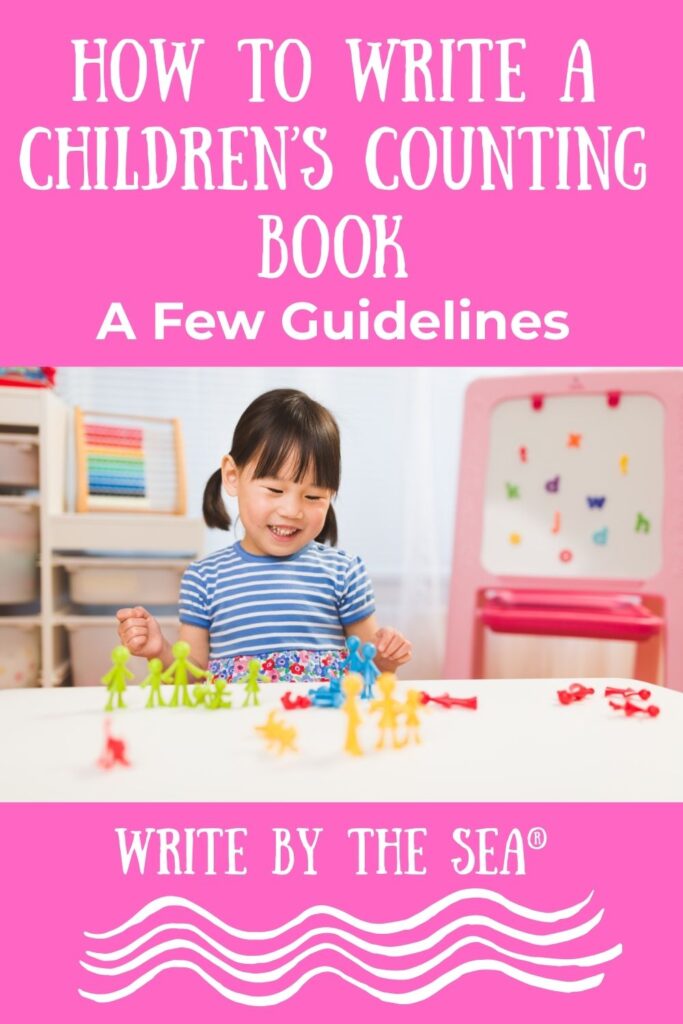Writing a children’s counting book requires a mix of simple storytelling, engaging visuals, and a strong educational foundation.

Here are the key guidelines to follow:
#1. Choose a Clear Counting Structure.
– Decide on the number range (e.g., 1–10, 1–20, or skip counting like 2s, 5s, 10s).
– Consider whether you want to count up (1 to 10) or count down (10 to 1).
– Example: Ten Black Dots by Donald Crews counts up to ten and uses a creative visual structure—each number of dots becomes part of a larger illustration.
#2. Use Simple and Engaging Language.
– Keep sentences short, rhythmic, and repetitive.
– Use fun, playful words to capture a child’s interest.
– Rhyme and alliteration can make the text more memorable.
– Example: Chicka Chicka 1, 2, 3 by Bill Martin Jr. and Michael Sampson uses lively rhyming language and a familiar alphabet-book rhythm to make counting fun.
#3. Incorporate a Theme or Story.
– A strong theme (e.g., animals, nature, space, adventure) makes counting more engaging.
– A simple narrative can tie the numbers together (e.g., “Ten little fish swimming in the sea…”).
– Example: Anno’s Counting Book by Mitsumasa Anno presents counting through seasons and scenes in nature, encouraging observation and storytelling without words.
#4. Encourage Interaction.
– Ask questions: “Can you count the stars?”
– Include prompts like “Find the missing butterfly!” to engage readers.
– Example: Count the Monkeys by Mac Barnett and Kevin Cornell turns counting into a full-on adventure, breaking the fourth wall to get readers involved on every page.
#5. Balance Repetition and Variety.
– Repetition helps reinforce learning (e.g., each page following a similar pattern).
– Introduce slight variations to keep it interesting (e.g., different animals, colors, or actions).
– Example: Mouse Count by Ellen Stoll Walsh uses repetition in both text and visual structure while building suspense as a snake counts mice into a jar—and then counts them back out again.
#6. Test for Readability.
– Read it out loud to ensure it flows smoothly.
– Ensure it’s appropriate for the target age group (board books for toddlers, picture books for preschoolers).
– Example: One Duck Stuck by Phyllis Root is a great read-aloud with a sticky, rhythmic refrain and clear counting cues perfect for toddlers and early preschoolers.
#7. Incorporate a Learning Takeaway.
– Reinforce concepts beyond just numbers (e.g., colors, shapes, emotions).
– Consider adding a bonus activity at the end (e.g., a counting game or a seek-and-find challenge).
– Example: Counting Kisses by Karen Katz mixes counting with affection and emotional connection, making it as much a bedtime routine as a numbers lesson.
When in doubt, head to the children’s section at your local library or bookstore and read a stack of counting books aloud.
Pay attention to what feels natural to say, what gets a giggle, and what holds your interest.
Then go write your own version—just as fun, just as smart, and all yours.
Now, before you go, if you haven’t subscribed to The Morning Nudge, be sure to do that now, so you get our Law of Attraction Checklist for Writers and free access to our Private Resource Library for Writers, as well as a short email every weekday morning to help you manifest your writing dreams!
Note: Posts and pages on this site may contain some affiliate links for your convenience (which means if you make a purchase after clicking a link I will earn a small commission but it won’t cost you a penny more)! Read my full disclosure and privacy policies…







